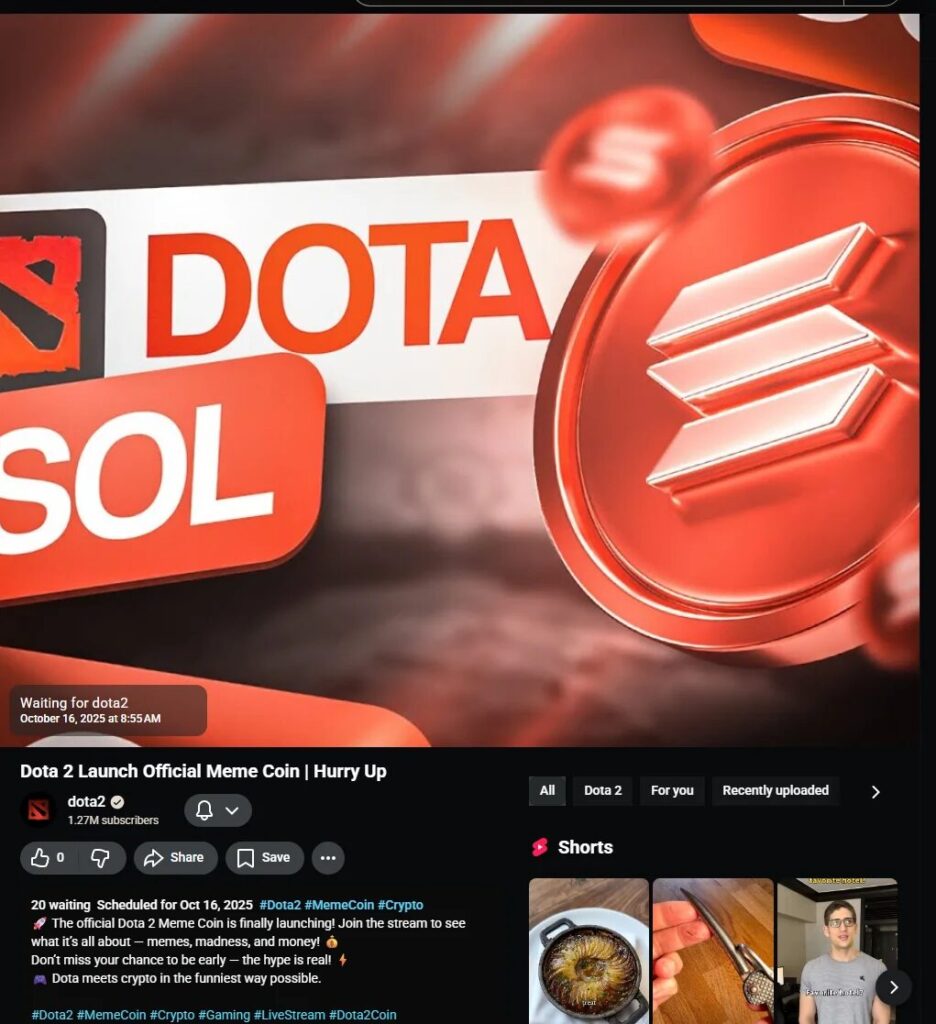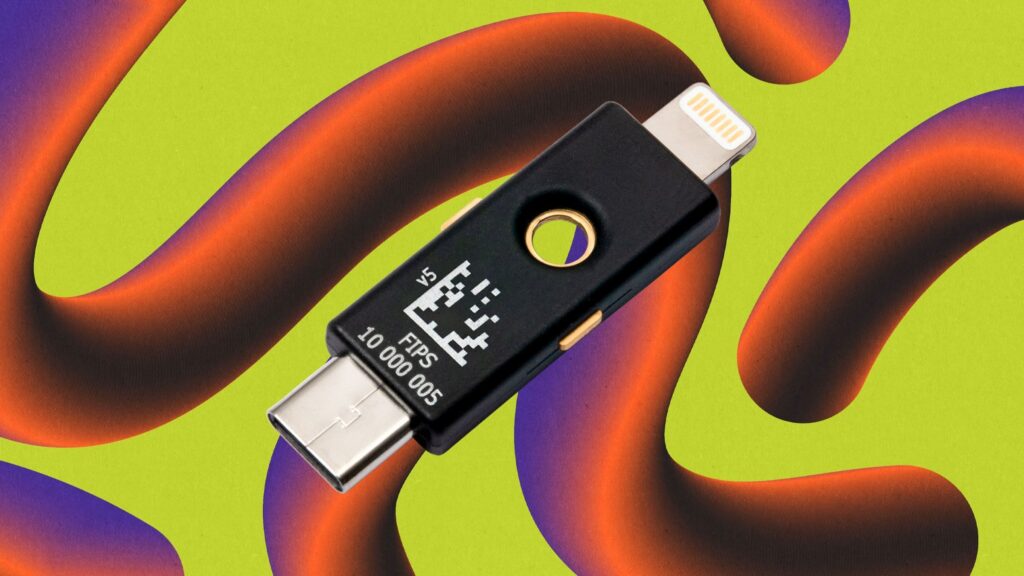Dota 2 YouTube Hack – On October 15, 2025, the gaming community was caught off guard when Dota 2’s official YouTube channel suddenly went live with what looked like a professional announcement from Valve. The stream promoted a new cryptocurrency called dota2coin, claiming to be the “official Dota 2 meme coin launch.”
The visuals and audio appeared authentic—official logos, sleek overlays, and tournament-level production quality. Even the title, “Dota 2 Launch Official Meme Coin | Hurry Up,” mirrored the style of real Valve announcements. But within minutes, fans realized something was off.
Instead of gameplay or patch notes, the video description contained links to Pump.fun, a legitimate Solana-based platform often used to create meme coins. The hackers used it to add credibility, directing viewers to buy dota2coin before it “sold out.”
Shortly after, the PGL YouTube channel—responsible for broadcasting official Dota 2 tournaments—was hijacked as well. The same fake livestream appeared there too, spreading panic among fans and content creators.
The Step-by-Step Breakdown of the Crypto Scam

The Dota 2 YouTube hack followed a clear sequence that made it look legitimate. Understanding each step helps explain why even experienced fans were briefly fooled.
Step 1: The Setup
Hackers likely gained access to verified YouTube accounts through phishing emails posing as brand partnership offers. Once they stole session tokens, they bypassed two-factor authentication and uploaded pre-recorded “official” content.
Step 2: The Launch
The fake livestream went live on Dota 2’s channel around 10:45 PM (GMT+8). Within an hour, identical streams appeared on PGL and other esports channels like ESL, BLAST Counter-Strike, and Mobile Legends MPL Indonesia.
Step 3: The Pump
The scam centered around a Solana meme coin—dota2coin. Its 98% wallet control by a single user made it a typical pump-and-dump token. Viewers who bought early lost their funds when scammers liquidated the holdings.
Here’s how the timeline unfolded:
| Time (GMT+8) | Event Summary |
|---|---|
| 10:45 PM | Dota 2 channel starts fake livestream |
| 11:30 PM | PGL YouTube channel also hijacked |
| 12:00 AM | Community spots the scam on Reddit and X |
| 2:00 AM | YouTube takes down fraudulent streams |
| 8:00 AM | Both channels restored to normal |
By the time the scam ended, the coin’s market cap briefly touched $5,000 before collapsing.
How the Scam Fooled Viewers

What made this attack so dangerous wasn’t just the hack itself—it was how convincing the livestream looked. Every visual cue and tone choice was built to earn trust fast.
The video featured smooth transitions, Valve’s recognizable Dota 2 Major branding, and an AI voice that mimicked an announcer. The chat section was filled with fake comments like “This is huge!” and “Finally Dota joins crypto!”
The attackers used three core psychological triggers:
- Authority: The video’s design looked official, borrowing Valve and PGL’s logos.
- Urgency: On-screen banners read “Hurry Up – Limited Coin Supply,” pushing people to act quickly.
- Social Proof: The same video playing across several verified channels made it feel real.
These social engineering methods are not new. In past years, fake Elon Musk crypto giveaways used similar techniques on YouTube, promising free tokens during “exclusive” livestreams. This time, the esports community was the target.
How the Hackers Got In – Dota 2 YouTube Hack

Security experts believe the attack used a phishing and session hijacking combo. Here’s how that process likely unfolded:
- Fake Sponsorship Email: Hackers sent emails pretending to be from sponsors or event organizers.
- Session Token Theft: Once the recipient clicked the embedded link, their YouTube session tokens were copied.
- Bypassing 2FA: With those tokens, attackers logged into YouTube directly—no need for passwords or verification codes.
- Content Upload: They uploaded fake livestream assets and set them to “Premiere,” making them appear live.
This method has become increasingly common since 2020, especially in high-profile YouTube channel takeovers involving crypto scams.
Security researchers also noticed that the breach coincided with a brief YouTube playback outage, suggesting a possible system-wide exploit, though this remains unconfirmed.
The coordinated timing—multiple esports channels compromised in under an hour—implies an organized group, not a solo hacker. The simultaneous blockchain activity and synchronized wallet transactions reinforce this theory.
Fan and Industry Reactions – Dota 2 YouTube Hack

The community’s response was fast and decisive. Within an hour of the streams going live, posts on r/DotA2 and r/esports warned users not to interact with any links in the livestream. Influencers like Brad Lynch and several Dota 2 casters amplified those warnings on X (formerly Twitter), tagging both YouTube and Valve support.
Thanks to that effort, YouTube removed the streams within hours and restored the compromised channels by the next morning. However, the silence from Valve and PGL frustrated fans who expected public updates or apologies.
Cybersecurity specialists weighed in with insights:
- Analysts linked this attack to a growing trend of crypto-related YouTube hijackings since 2020.
- Solana educators like Solandy reminded users that while platforms such as Pump.fun are legitimate, scammers often misuse them.
- Esports security advocates suggested mandatory hardware-based authentication for official channels and frequent system audits.
The situation also sparked a viral phrase across gaming communities: “Verify before you vibe.” It captured the importance of checking sources before trusting any livestream that looks too good to be true.
What the Dota 2 YouTube Hack Means for the Future of Esports Security

The Dota 2 YouTube hack is more than a one-time incident—it’s a warning for the future of gaming security. As esports continues merging with blockchain and Web3 projects, the risks will grow.
For YouTube, the hack exposed a need for stronger real-time breach detection and better communication channels for verified creators. Automated systems should flag major changes, like title edits or sudden livestreams, from high-profile accounts.
For esports organizations, the lessons are straightforward:
- Train staff to identify phishing emails.
- Use hardware keys instead of SMS-based 2FA.
- Limit how many people can access official channels.
- Run routine security checks before major broadcasts.
Fans also play a role in maintaining trust. They can stay safe by:
- Avoiding links in video descriptions unless verified on official websites.
- Watching for unusual upload activity on official channels.
- Reporting fake streams quickly to YouTube or moderators.
The overlap between gaming and crypto will only deepen as digital assets become part of esports marketing. But as this event showed, trust can be weaponized as easily as technology.
Closing Thought – Dota 2 YouTube Hack
The Dota 2 YouTube hack reminded everyone that esports isn’t just about gameplay—it’s about safeguarding digital identity. As competitive gaming expands into crypto and blockchain spaces, keeping accounts secure isn’t just technical hygiene; it’s part of protecting the entire community’s trust.

